Russia To Send Iskander Ballistic Missile Systems To Siberia By September, Report Says

Russia’s armed forces in East Siberia will be trained and equipped with a new set of Iskander ballistic missile systems by September, a Russian military spokesman said Monday. The Kremlin has dispatched several Iskander missile systems to its territories in recent months amid clashes with Western leaders over Russia’s increased military activity in Eastern Europe.
“The servicemen of the missile formation of the Eastern Military District have received Iskander tactical missile systems. The systems cover a brigade set, which comprises over 50 pieces of combat hardware,” Col. Alexander Gordeyev, a spokesman for Russia’s eastern military district told Russian news agency Tass.
Russia military personnel will first be trained on how to operate the Iskander missile system in southern Russia, where they will perform tactical exercises and conduct test-launches, Gordeyev added. Training was expected to be completed by September 2015, at which point both the crews and the missile systems will be shipped by train to Buryatia, a region in Siberia. Russia touted the Iskander system as capable of striking targets up to 500 kilometers, or about 310 miles away.
The exercises by Russia’s eastern military district were expected to follow similar drills conducted by armed forces personnel in other regions. Russia’s southern military district carried out live-fire exercises earlier this month, and its central military district performed test-launches in January, Sputnik International News reported.
Members of the NATO alliance, including the Baltic States of Latvia, Lithuania and Estonia, have expressed growing concern with Russian military activity in Eastern Europe. The United States and NATO have bolstered their own military presence in the region, with the deployment of additional heavy weaponry to NATO nations and the potential introduction of a long-planned “anti-missile shield,” elements of which have already been deployed in Poland and Romania.
Despite its own missile drills, Russia warned the Baltic States last month that hosting NATO’s anti-missile shield would make them “targets” in any future conflict.
© Copyright IBTimes 2024. All rights reserved.






















